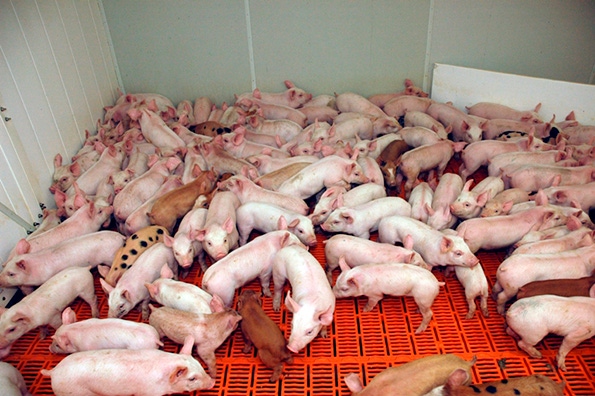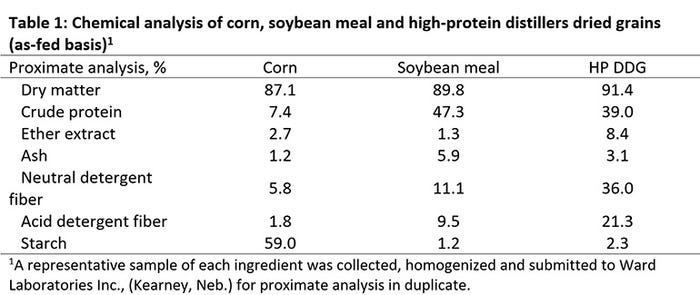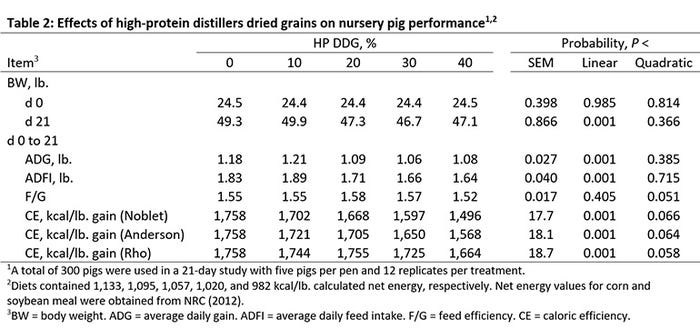Increasing HP DDGS in late-nursery diets led to a decrease in performance.
November 14, 2019

Distillers dried grains with solubles is a co-product of the ethanol industry that is widely used in swine diets. New processing techniques are being developed to remove nonfermentable components before fermentation that result in high protein distillers dried grains with approximately 40% crude protein. The new product generated has a different chemical composition and nutritive value for swine diets.
Recently, research determined the standardized ileal digestibility of amino acids and digestible energy content of HP DDG and observed similar amino acids digestibility but approximately 25% greater digestible energy than conventional DDGS. However, no growth performance data on this specific product had been completed.
The objective of this study was to determine the growth performance of pigs fed increasing amounts of HP DDG and to evaluate its productive energy content. The study was conducted at the Kansas State University Segregated Early Weaning Facility in Manhattan. A total of 300 pigs (DNA 400 x 200; initially 24.5 pounds) were used in a 21-day growth trial with five pigs per pen and 12 replicates per treatment. At arrival at the research facility, pigs were randomly placed in pens and fed common diets for 21 days until they reached approximately 25 pounds. On Day 21 after arrival, which was considered Day 0 of the experiment, pens of pigs were blocked by weight and randomly assigned to one of five dietary treatments. Treatments consisted of corn-soybean meal diets with increasing levels of HP DDG at zero, 10, 20, 30 or 40% of the diet. The inclusion of HP DDG was done at the expense of corn and feed-grade amino acids while soybean meal inclusion was held constant. Feed-grade amino acids were assigned NE values of 1,529, 1,876, 1,334, 2,168, 1,962 and 2,162 kcal/lb. for L-lysine HCl, DL-methionine, L-threonine, L-tryptophan, L-valine and L-isoleucine, respectively. Diets were not balanced for net energy. Experimental diets were fed for 21 days. Pigs were weighed and feed disappearance was measured on Day 0, 7, 14 and 21 to determine ADG, ADFI and F/G.

Caloric efficiency was obtained by multiplying ADFI by kcal of net energy per pound of diet and dividing by ADG. Corn and soybean meal were assigned net energy values obtained from the National Research Council (2012). The net energy value for HP DDG was estimated utilizing three different methods to determine net energy: 1) Equations from Noblet and Perez (1993) and Noblet et al. (1994); 2) Equations from Anderson et al. (2012) Noblet et al. (1994); or 3) Equations from Rho et al. (2017) and Noblet et al. (1994). Based on the caloric efficiency, a predicted net energy value for each treatment that contained HP DDG compared to the corn-soybean meal diet was calculated and average productive energy was estimated.
Overall (Day 0 to 21), pigs fed diets with increasing HP DDG had a linear decrease in ADG, ADFI and final weight. There was a tendency for a quadratic response in feed efficiency, with the best feed efficiency observed for pigs fed the diet with 40% HP DDG.

For energy determination, there was a decrease in caloric efficiency as HP DDG increased, which indicates that the net energy of HP DDG was underestimated. Results suggest that in order to obtain a caloric efficiency similar to the corn-soybean meal diet, the net energy value of HP DDG should be 1,218 kcal/lb. or 97.3% of corn net energy. In comparison, the initial net energy value was 69.2% of corn net energy using the Noblet and Perez (1993) and Noblet et al. (1994) equations, 78.6% of corn net energy using the Anderson et al. (2012) Noblet et al. (1994) equations, and 91.2% of corn net energy using the Rho et al. (2017) and Noblet et al. (1994) equations.
In summary, increasing HP DDGS in late-nursery diets led to a decrease in performance. Based on caloric efficiency, the productive energy of HP DDG is approximately 97% of corn NE. Full information on this research study will be available at the 2019 KSU Swine Day Nov. 21.
Sources: Henrique S. Cemin, Mike D. Tokach, Steve S. Dritz, Jason C. Woodworth, Joel M. DeRouchey, Robert D. Goodband and Mallorie Wilken, who are solely responsible for the information provided, and wholly own the information. Informa Business Media and all its subsidiaries are not responsible for any of the content contained in this information asset.
You May Also Like



